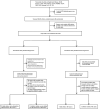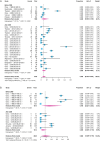Global estimation of dengue disability weights based on clinical manifestations data
- PMID: 40484939
- PMCID: PMC12147332
- DOI: 10.1186/s40249-025-01317-5
Global estimation of dengue disability weights based on clinical manifestations data
Abstract
Background: Dengue is a major global health threat with varied clinical manifestations across age groups, countries, and regions. This study aims to estimate global dengue disability weights (DWs) based on clinical manifestations data and examine variations across different demographics and geographical areas. These findings will inform public health strategies and interventions to reduce the global burden of dengue.
Methods: We conducted a systematic search across six databases (Scopus, Web of Science, PubMed, China National Knowledge Infrastructure, Wanfang Data, and Database of Chinese sci-tech periodicals) for studies on human dengue clinical manifestations or infection from the establishment of each database through December 31, 2023. DWs were estimated by combining clinical manifestations frequencies with corresponding DW values derived from the Global Burden of Disease (GBD) study, using Monte Carlo simulations to generate uncertainty intervals. Odds ratios (ORs) with 95% confidence intervals (CI) and Chi-square tests were performed to compare clinical manifestations between adults and children.
Results: A total of 35 adult studies (7109 cases) and 17 pediatric studies (2996 cases) were analysed. Adults had higher rates of muscle pain (OR = 9.18; 95% CI: 8.17-10.33) and weak (OR = 4.95; 95% CI 4.12-5.98). Children showed higher frequencies of decreased appetite (OR = 0.12; 95% CI: 0.11-0.14) and lymphadenectasis (OR = 0.04; 95% CI: 0.03-0.06). Severe dengue was more prevalent in children (8.2%) than adults (4.6%). The global DW for universal dengue was 0.3258 in adults and 0.4022 in children, with Indian children showing the highest DW for severe dengue (0.6991) and Chinese adult showing the highest DW for severe dengue (0.7214). Regionally, most studies were from South and Southeast Asia, with India contributing the largest number of publications (80 articles). Additionally, India had the highest dengue disease burden in 2021 (352,468.54 person-years).
Conclusions: These findings reveal important age and regional differences in dengue disease burden. There is a relative lack of research on dengue clinical manifestations in several high-burden countries in the Americas, and these gaps may affect the comprehensiveness and accuracy of global dengue disability weight estimates. These highlight the urgent need for targeted interventions and optimized resource allocation to mitigate its global impact.
Keywords: Clinical manifestation; Dengue; Disability weight; Meta-analysis; Region-specific.
© 2025. The Author(s).
Conflict of interest statement
Declarations. Ethics approval and consent to participate: This study utilized secondary data extracted from publicly available sources and previously published literature. No direct interactions with human or animal subjects were involved. Therefore, ethical approval and informed consent were not required. Consent for publication: Not applicable. Competing interests: Guo-Jing Yang is an editorial board member of the journal Infectious Diseases of Poverty. She was not involved in the peer-review or handling of the manuscript. The authors have no other competing interests to disclose.
Figures



Similar articles
-
Systemic pharmacological treatments for chronic plaque psoriasis: a network meta-analysis.Cochrane Database Syst Rev. 2021 Apr 19;4(4):CD011535. doi: 10.1002/14651858.CD011535.pub4. Cochrane Database Syst Rev. 2021. Update in: Cochrane Database Syst Rev. 2022 May 23;5:CD011535. doi: 10.1002/14651858.CD011535.pub5. PMID: 33871055 Free PMC article. Updated.
-
Trends and levels of the global, regional, and national burden of appendicitis between 1990 and 2021: findings from the Global Burden of Disease Study 2021.Lancet Gastroenterol Hepatol. 2024 Sep;9(9):825-858. doi: 10.1016/S2468-1253(24)00157-2. Epub 2024 Jul 17. Lancet Gastroenterol Hepatol. 2024. PMID: 39032499 Free PMC article.
-
Drugs for preventing postoperative nausea and vomiting in adults after general anaesthesia: a network meta-analysis.Cochrane Database Syst Rev. 2020 Oct 19;10(10):CD012859. doi: 10.1002/14651858.CD012859.pub2. Cochrane Database Syst Rev. 2020. PMID: 33075160 Free PMC article.
-
Surgical interventions for treating extracapsular hip fractures in older adults: a network meta-analysis.Cochrane Database Syst Rev. 2022 Feb 10;2(2):CD013405. doi: 10.1002/14651858.CD013405.pub2. Cochrane Database Syst Rev. 2022. PMID: 35142366 Free PMC article.
-
Systemic pharmacological treatments for chronic plaque psoriasis: a network meta-analysis.Cochrane Database Syst Rev. 2017 Dec 22;12(12):CD011535. doi: 10.1002/14651858.CD011535.pub2. Cochrane Database Syst Rev. 2017. Update in: Cochrane Database Syst Rev. 2020 Jan 9;1:CD011535. doi: 10.1002/14651858.CD011535.pub3. PMID: 29271481 Free PMC article. Updated.
References
-
- World Health Organization. WHO results report: Region of the Americas. 2024. https://www.who.int/about/accountability/results/who-results-report-2024.... Accessed 16 May 2025.
-
- World Health Organization. Ending the neglect to attain the sustainable development goals: a road map for neglected tropical diseases 2021–2030. Geneva: World Health Organization, 2020. https://www.who.int/publications/i/item/9789240010352. Accessed 16 May 2025.
-
- Murray CJ, Lopez AD. Measuring the global burden of disease. N Engl J Med. 2013;369(5):448–57. 10.1056/NEJMra1201534. - PubMed
Publication types
MeSH terms
Grants and funding
- 2022B1111030002/the Key R&D Program of Guangdong Province
- 2023A03J0810/Basic and applied basic research project jointly funded by the University of Guangzhou
- 001/WHO_/World Health Organization/International
- 2021YFC2300800/National Key Research and Development Program of People's Republic of China
- 82260655/National Natural Science Foundation of China
LinkOut - more resources
Full Text Sources
Medical

